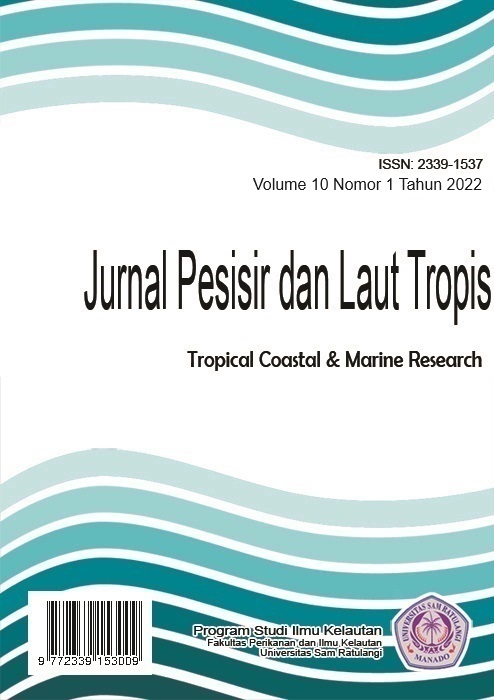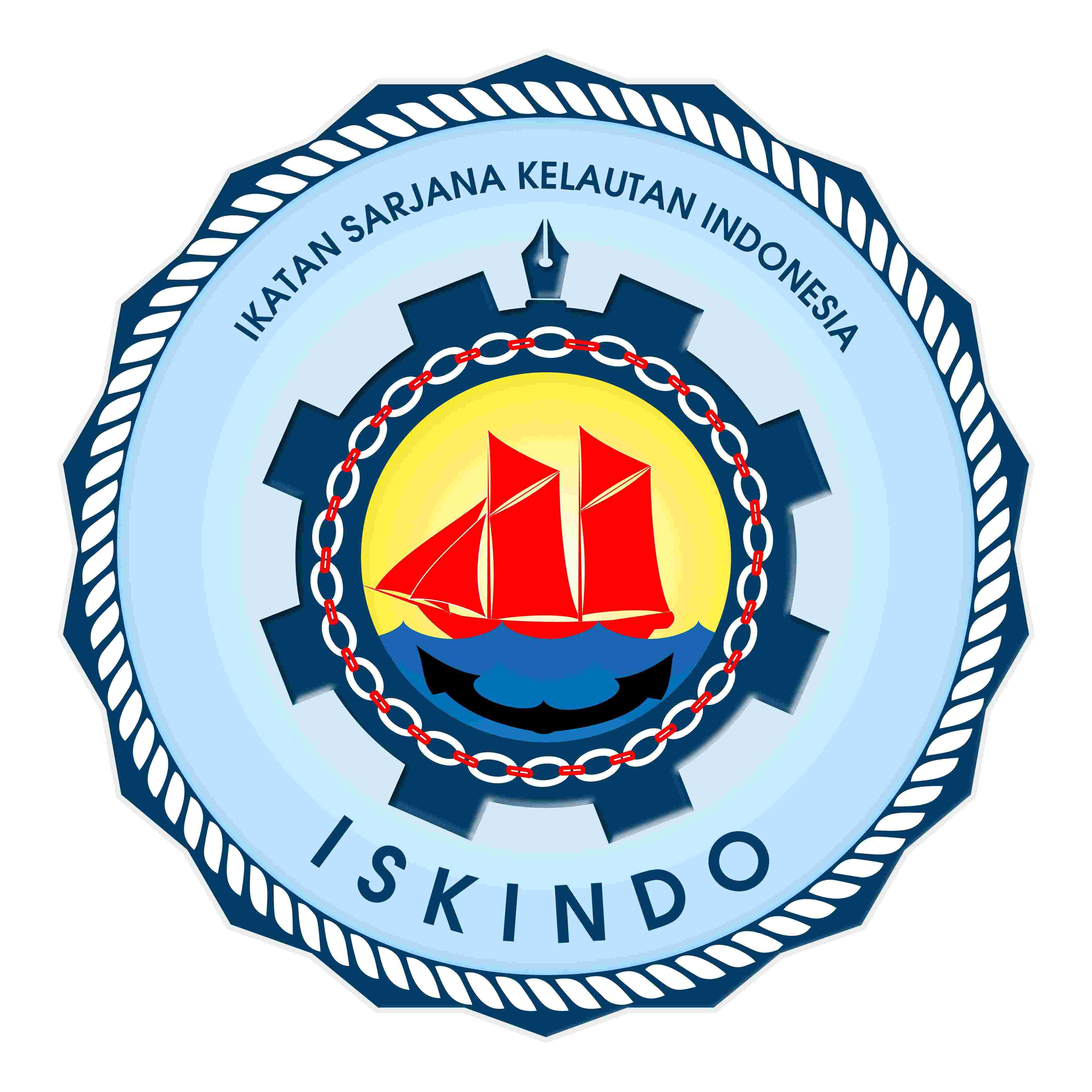KEMAMPUAN SENYAWA PATELAMIDA E DARI Prochloron didemni ASAL TELUK MANADO SEBAGAI INHIBITOR REPLIKASI SARS-CoV-2 BERDASARKAN KAJIAN PENAMBATAN MOLEKULER DENGAN AUTODOCK
DOI:
https://doi.org/10.35800/jplt.10.1.2022.54943Keywords:
Penambatan molekuler; nsp 13; patelamida E; SARS-CoV-2; mikroba lautAbstract
he COVID-19 pandemic caused by the severe acute respiratory syndrome coronavirus 2 (SARS-CoV-2) has lead to a global health emergency. The outbreak of COVID-19 to date indicates an urgency to find and develop effective therapeutic agents. One alternative that needs to be explored is to design drug candidates from marine fauna. Marine microbes have promising molecular potential as a source of pharmaceutical biomaterials, including Prochloron didemni which associated with Ascidiacea belongs to the invertebrate subphylum Tunicata in Manado Bay, North Sulawesi. This microbe has been isolated from its host Lissoclinum patella and cultivated in the laboratory. P. didemni has been reported to produce several cyclic peptides including patelamide E compound. One approach to develop this compound as antiviral drug is in silico analysis using AutoDock. This analysis aims to predict the ability of patelamide E compounds to inhibit the activity of the non-structural protein (nsp13) SARS-CoV-2 which is known to play an important role in the viral replication. Its molecular structure was downloaded from the RCSB Protein Database with ID 6ZSL. As ligands, the molecular structure of patelamide E and the recommended drugs for COVID-19 (ivermectin, remdesivir, malnupiravir, favipiravir and oseltamivir) were downloaded from https://pubchem.ncbi.nlm.nih.gov/. The binding affinity between the protein and the ligand was assessed using AutoDock and visualized by PyMol. The results show that the free energy (∆G) value of -15.4 kcal/mol was obtained for binding affinity of patelamide E towards nsp13 SARS-CoV-2, indicating that this compound could inhibit the viral replication. The inhibitory ability of patelamide E is stronger than the recommended drugs (ivermectin, remdesivir, malnupiravir, favipiravir and oseltamivir) with ∆G values ranged from -6.7 to -13.7 kcal/mol. This analysis is obviously necessary to accomplish with further computer simulation for assesing the binding stability. The potential of patelamide E as an anti-SARS-CoV-2 drug candidate should be more clinically assayed after in vitro and in vivo analyses.
Keywords: Molecular docking, nsp 13, patellamide E, SARS-CoV-2, marine microbes
ABSTRAK
Pandemi COVID-19 yang disebabkan oleh severe acute respiratory syndrome coronavirus 2 (SARS-CoV-2) telah menyebabkan situasi darurat kesehatan secara global. Hal ini jelas memunculkan kebutuhan untuk menemukan dan mengembangkan agen terapeutik yang efektif. Alternatif yang perlu dijajaki adalah mendesain kandidat obat dari fauna laut. Mikroba laut memiliki potensi molekuler yang menjanjikan sebagai sumber bahan farmasi, termasuk Prochloron didemni yang ditemukan hidup berasosisasi dengan golongan Ascidiacea, avertebrata dari subfilum Tunikata di Teluk Manado, Sulawesi Utara. Mikroba ini telah berhasil diisolasi dari inangnya Lissoclinum patella dan dikultivasi di laboratorium. P. didemni dilaporkan menghasilkan beberapa peptida siklik termasuk senyawa patelamida E. Salah satu pendekatan yang dapat ditempuh yaitu analisis in silico menggunakan perangkat lunak AutoDock. Analisis ini bertujuan untuk memprediksi kemampuan senyawa patelamida E dalam menghambat aktivitas protein nonstruktural (nsp13) SARS-CoV-2 yang diketahui berperan dalam proses replikasi virus tersebut. Struktur protein diunduh dari RCSB Protein Data Bank dengan ID 6ZSL. Sebagai ligan, struktur molekul patelamida E dan obat yang direkomendasikan untuk COVID-19 (ivermectin, remdesivir, malnupiravir, favipiravir dan oseltamivir) diunduh dari https://pubchem.ncbi.nlm.nih.gov/. Afinitas ikatan antara protein dan ligan didapatkan dari pengoperasian perangkat lunak AutoDock dan divisualisasikan menggunakan PyMol. Hasil penambatan patelamida E pada nsp13 SARS-CoV-2 dalam parameter energi bebas (∆G) sebesar -15.4 kcal/mol mengindikasikan bahwa senyawa ini dapat menghambat replikasi virus tersebut. Kemampuan hambat patelamida E lebih kuat dari obat-obat yang direkomendasikan (ivermectin, remdesivir, malnupiravir, favipiravir dan oseltamivir) yang nilai ∆G-nya berkisar -6.7 hingga -13.7 kcal/mol. Analisis ini perlu dilanjutkan dengan simulasi komputer untuk mengkaji kestabilan ikatan antara ligan dan protein. Potensi senyawa patelamida E sebagai kandidat obat anti SARS-CoV-2 perlu diuji klinis yang didahului dengan analisis in vitro dan in vivo.
Kata kunci: Penambatan molekuler, nsp 13, patelamida E, SARS-CoV-2, mikroba laut
References
Ameen, F., Nadhari, S., Al-Homaidan, A.A. 2021. Marine microorganisms as an untapped source of bioactive compounds. Saudi Journal of Biological Sciences 28 (1): 224
Dias, R., Azevedo, W.F. 2008. Molecular docking algorithms. Current Drug Targets 9 (12): 1040-1047.
Donia, M.S., Hathaway, B.J., Sudek, S., Haygood, M.G., Rosovitz, M.J, Ravel, J,. Schmidt, E.W. 2006. Natural combinatorial peptide libraries in cyanobacterial symbionts of marine ascidians. Nature chemical biology 2 (12): 729-735.
Du, X., Li, Y., Xia, Y.L., Ai, S.M., Liang, J., Sang, P., Ji, X.L. Liu, S.Q. 2016. Insights into protein- ligand interactions: mechanisms, models, and methods. International journal of molecular sciences 17 (2): 144
Jain, A.N., Nicholls, A. 2008. Recommendations for evaluation of computational methods. Journal of computer-aided molecular design 22 (3): 139
Jiang, Y, Wanchao Y,, Xu HE. 2020. RNA- dependent RNA polymerase: Structure, mechanism, and drug discovery for COVID-19. Biochem. Biophys.
McDonald, L.A., Ireland, C.M. 1992. Patellamide E: a new cyclic peptide from the ascidian Lissoclinum patella. Journal of natural products 55 (3): 376-379.
Newman, J.A., Douangamath, A., Yazdani, S., Yosaatmadja, Y., Aimon, A., Brandao-Neto, J., Gileadi, O. 2021. Structure, Mechanism and Crystallographic fragment screening of the SARS-CoV-2 NSP13 helicase. Nat Commun 12: 4848
Ortega, J.T., Jastrzebska, B., Rangel, H.R., 2022. Omicron SARS-CoV-2 Variant Spike Protein Shows an Increased Affinity to the Human ACE2 Receptor: An In Silico Analysis. Pathogens, 11: 45
Rumengan, I.F.M., Roring, V.I.Y., Haedar, J.R., Siby, M.S., Luntungan, A.H., Kolondam, B.J., Uria, A.R., Wakimoto, T. 2021. Ascidian- associated photosymbionts from Manado, Indonesia: secondary metabolites, bioactivity simulation, and biosynthetic insight. Symbiosis, 84 (1), 71-82.
Rumengan, I.F.M. 2021. Mikroba Laut sebagai Penyedia Perangkat Penyuntingan Genom, dalam Pengelolaan Sumberdaya Laut Berkelanjutan. Unsrat Press.
Schmidt, E.W., Sudek, S., Haygood, M.G. 2004. Genetic evidence supports secondary metabolic diversity in Prochloron spp., the Cyanobacterial Symbiont of a tropical ascidian. Journal of natural products 67 (8): 1341-1345.
Schmidt, W.E., Nelson, J.T., Rasko, D.A., Sudek, S., Eisen, J.A., Haygood, M.G., Ravel, J. 2005. Patellamide A and C biosynthesis by a microcin-like pathway in Prochloron didemni, the cyanobacterial symbiont of Lissoclinum patella. Proceedings of the National Academy of Sciences, 102(20),315-320.
Spratt, A.N., Gallazzi, F., Quinn, T.P., Lorson, C.L., Sönnerborg, A., Singh, K. 2021. Coronavirus helicases: attractive and unique targets of antiviral drug- development and therapeutic patents. Expert opinion on therapeutic patents, 31 (4), 339–350.
Tian, D., Sun, Y., Zhou, J., Ye, Q. 2021. The Global Epidemic of the SARS-CoV-2 Delta Variant, Key Spike Mutations and Immune Escape. Frontiers in immunology, 12: 751-778
White, M.A., Lin, W., Cheng, X. 2020. Discovery of COVID-19 inhibitors targeting the SARS-CoV-2 Nsp13 helicase. The Journal of physical chemistry letters 11 (21), 9144-9151.
Downloads
Published
How to Cite
Issue
Section
License

This work is licensed under a Creative Commons Attribution-NonCommercial 4.0 International License.
















